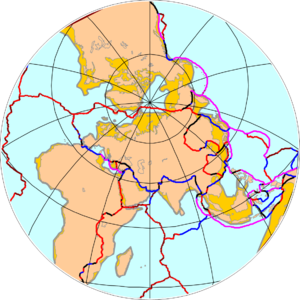
The Eurasian plate.
The Eurasian Plate is a tectonic plate which includes most of the continent of Eurasia (a landmass consisting of the traditional continents of Europe and Asia), with the notable exceptions of the Indian subcontinent, the Arabian subcontinent, and the area east of the Chersky Range in East Siberia. It also includes oceanic crust extending westward to the Mid-Atlantic Ridge and northward to the Gakkel Ridge.
The eastern side is a boundary with the North American Plate to the north and a boundary with the Philippine Sea Plate to the south, and possibly with the Okhotsk Plate and the Amurian Plate. The southerly side is a boundary with the African Plate to the west, the Arabian Plate in the middle and the Indo-Australian Plate to the east. The westerly side is a divergent boundary with the North American Plate forming the northernmost part of the Mid-Atlantic Ridge, which is straddled by Iceland. The 1973 eruption of Eldfell, the volcano of the Icelandic island Heimaey, caused by the North American and the Eurasian plates moving apart, is a result of divergent plate boundary forces.

Eurasian & Anatolian Plate
The geodynamics of central Asia is dominated by the interaction between the North Eurasia and India Plates. In this area, many subplates or crust blocks have been recognized. These subplates or crust blocks form the Central Asian transit zone and the East Asian transit zone.[1]
Notes
- ↑ "Up-to-Date Geodynamics and Seismicity of Central Asia" by Y. Gatinsky, D. Rundquist, G. Vladova, T. Prokhodova
|
|---|
| | Major | | |
|---|
| | Minor | |
|---|
| | Other | |
|---|
| | Historical | |
|---|
|
|
|---|
| | Geographic regions |
Countries | |
|---|
| Other geographic entities
associated with Europe | |
|---|
| |
|---|
| | Geologic regions |
| |
|---|
| |
- Atlantic
- Arctic Ocean
- Barents Sea
- Black Sea
- Mediterranean
- White Sea
|
|---|
| | |
|---|
| Tectonic plates and
microcontinents | |
|---|
| | |
|---|
|
|---|
|



